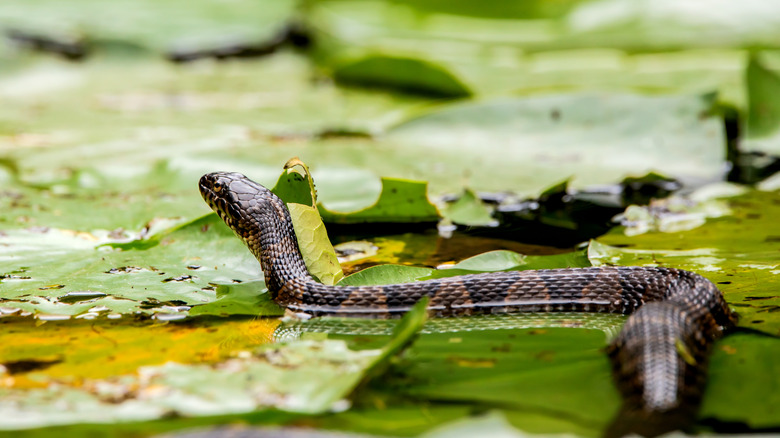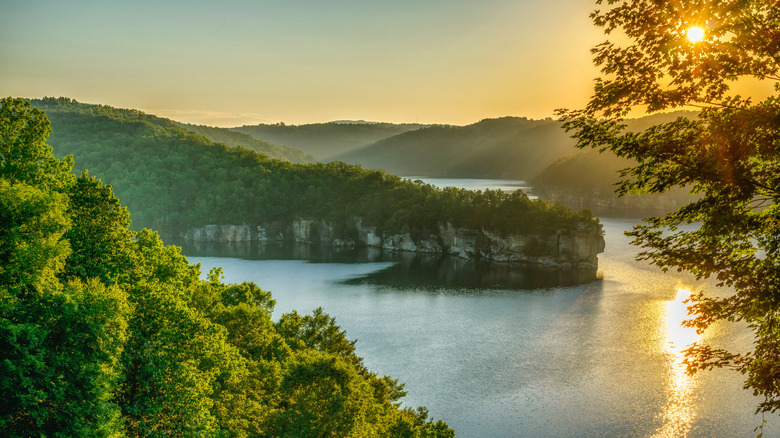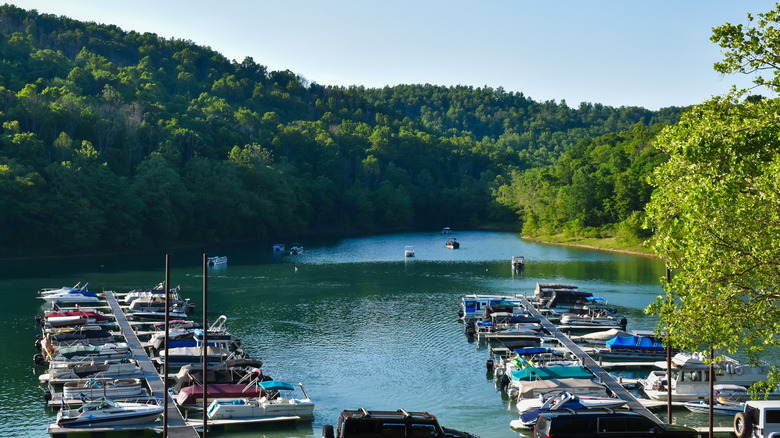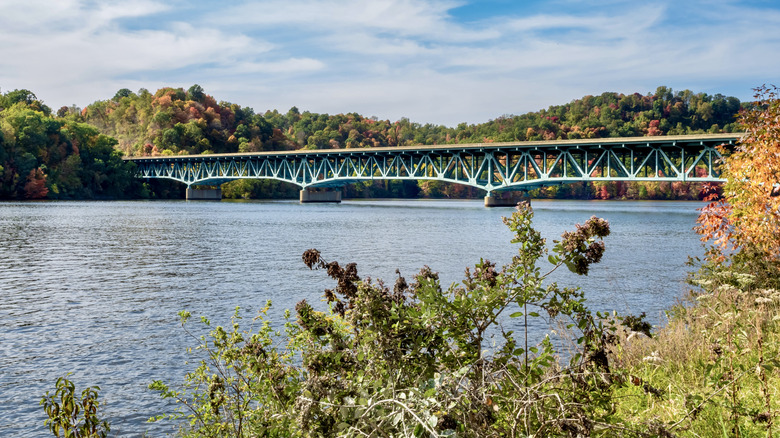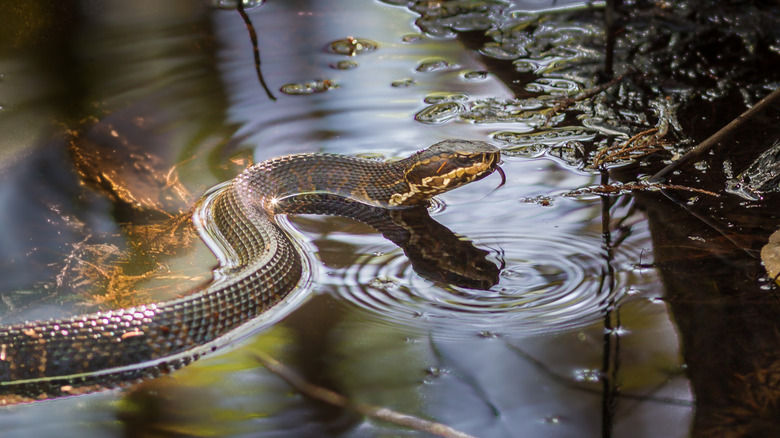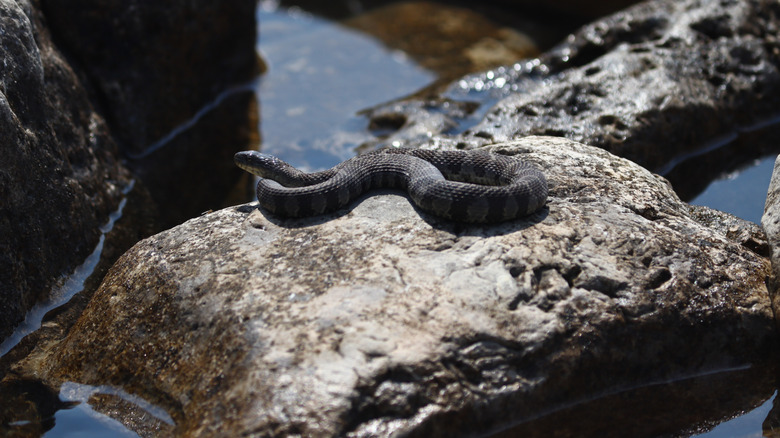These Iconic, Wild, And Beautiful West Virginia Waters Might Also Be The Most Snake-Heavy
We may receive a commission on purchases made from links.
West Virginia is a treasure trove of stunning landscapes, eclectic towns, and water bodies. With over 120 ponds and lakes in the state, you're never too far from a picturesque boating, swimming, or fishing spot. Some water landscapes require a bit of a walk to get to, like West Virginia's most photographed waterfall, hidden inside Blackwater Falls State Park. However, even if you're not hiking to your destination, getting to most watery getaways will require navigating some wilderness, which means watching out for snakes. Because of the Mountain State's rich natural surroundings, it is home to a wide variety of flora and fauna, including over 20 snake species.
Fortunately, only two species of snakes found in West Virginia are venomous — the copperhead and the timber rattlesnake — and neither are water snakes. In fact, the only water snake found in West Virginia is the northern water snake, which is non-venomous but may bite if it feels threatened. With its earthy gray-brown coloring and dark bands, the northern watersnake can often be confused with the venomous cottonmouth.
Several other non-venomous snake varieties found in West Virginia can often be spotted swimming or basking on the ground near bodies of water, while not technically water snakes. These include rat snakes, queen snakes, garter snakes, and more. While a bite from any of these species won't be fatal, it can still hurt and will require first aid. Therefore, it's best to keep an eye out for them, especially around some of West Virginia's waters that are most known for hosting our slithery friends. It's good practice to wear boots and even some protective gear, like these QOGIR Snake Gaiters, to avoid mishaps when you're enjoying the Mountain State scenery.
Summersville Lake
Summersville Lake is the largest lake in West Virginia. Just over 60 miles east of Charleston, it is spread over a whopping 2,700 acres. To its north lies Summersville Lake State Park, a rock-climbing hotspot with multiple camping grounds and RV sites. Understandably, the area gets a large number of visitors, especially along the lake's 60-mile shoreline. It also hosts a healthy snake population, and while most of them are northern water snakes that are non-venomous and defensive, there have been sightings of copperheads in the lake, which could pose a real danger.
Fortunately, copperhead sightings are rare since these snakes generally avoid water. If you think you've spotted one in the lake, make sure that it is, indeed, a copperhead and not a northern water snake, which has similar dark band markings. One way is to pay attention to how the snake swims. Water snakes will generally swim underwater, while a copperhead swims with its head above water. If you do see a snake that matches the markings and is swimming with its head above water, it's a good idea to be wary.
Tygart Lake
If you're heading to Elkins, an eclectic West Virginia town known for outdoor adventures, you'll probably end up visiting Tygart Lake, which is less than an hour's drive away. While it isn't as big as Summersville Lake and has a shoreline roughly 10 miles long, the views here are stunning, with the Allegheny Mountains forming the backdrop. The lake is popular for fishing, swimming, and canoeing, and has several access points, including a sandy beach near the Tygart Adventure Lake area.
The lake itself is home to several semi-aquatic species, including corn snakes, black rat snakes, and milk snakes. While these are not venomous, they can still bite, and it's best to keep an eye out for them when you're in the lake. You need to be particularly careful when accessing the lake from points where there are fewer facilities and more foliage, since the chances of encountering a snake could be higher. There are also several hiking trails around, and while water snakes in West Virginia are harmless, venomous copperheads are occassionally spotted in the area.
Cheat Lake
Cheat Lake, situated in Monongalia County along the state's northern border, is once again abundant in fish after a dip in numbers some years ago. The lake and the area around it are now popular for fishing, kayaking, and hiking, with multiple restaurants making it a fun destination for more leisure-inclined visitors. Cheat Lake Park, accessible by both boat and car, has a trail along the lake and is a great place to picnic or jump in for a swim. However, note that there are no lifeguards on duty.
While it's a great destination for fishing enthusiasts, the lake also attracts snakes that feed on fish, making it one of the most snake-infested in the state. The nearby Coopers Rock State Forest, a picturesque West Virginia Destination for fall colors that's great for hiking, also hosts a healthy population of timber rattlesnakes, which often venture into the lake's vicinity. In fact, there have been several reports of snake sightings in the area, including the venomous rattlesnake, making Cheat Lake one place where you have to be particularly careful. The fact that the Snake Hill Wildlife Management Area is also in the vicinity is a good reminder to watch out for the reptiles, but this shouldn't stop you from enjoying the area's over 3,000 acres of forested highlands.
Ohio River
The Ohio River is a vast watery ribbon on the border of Ohio and West Virginia, flowing through six states altogether. This also makes it by far the most commercially busy water body on this list, with transportation industries using it as a waterway and power plants along its shore. While swimming here is not recommended, there are dozens of islands in the section of the Ohio River passing through West Virginia. These islands, part of the Ohio River Islands National Wildlife Refuge, are open to visitors and accessible by boat.
Because of the rich biodiversity of the islands, there is a relatively wider variety of snakes that can be found around the Ohio River. Fortunately, this doesn't mean there are more venomous snakes to deal with over here. However, you will find species like the ribbon snake, queen snake, and eastern fox snake. The Ohio Valley river snake and ubiquitous northern water snake can also be found here. It's better to be safe than sorry and steer clear of the snakes, but know that most, if not all, that you'll see in the Ohio River are non-venomous.
Beech Fork Lake
Beech Fork Lake, one of the smallest bodies of water in this list, is an idyllic spot for swimming, fishing, and boating in the hills of West Virginia, around Wayne and Cabell counties. Just 10 miles from Huntington, the lake has nearby camping grounds, a visitor center, and well-equipped picnic shelters. While there is a nominal fee for swimming, there are no lifeguards, so it's important to take precautions when getting into the water.
Beech Fork Lake also happens to be one of the most densely populated with snakes. The Beech Fork Lake Wildlife Management Area is a lush area with ample biodiversity, meaning there is a lot of prey to support the healthy snake population. In and around the lake, you can find rat snakes, eastern garter snakes, and northern water snakes, all of which feed on small creatures like frogs, rats, and squirrels in the area. You have to be particularly careful if you decide to hike in the surrounding hilly forrested areas, since this is where copperheads and timber rattlesnakes tend to congregate. These venomous species often bask on rocks or may even be under thick foliage, so keep a sharp eye out for them. When in doubt, do not approach the snake. Since they are generally non-aggressive unless threatened, it's best to slowly walk backwards and away from the snake to avoid any mishaps.
